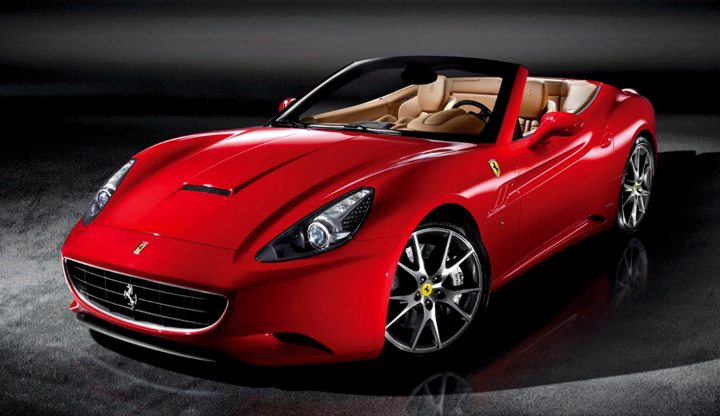Maverick Life
Ferrari California 30: Fast forward!

Conceived with passion and infused with desire, Italian sports cars are much more than mere speed machines. Nor is driving them just a matter of covering ground; it’s an occasion, with a thoroughbred engine providing a suitably emotive soundtrack. Add coachwork drenched in a scarlet hue and chances are it’s a Ferrari. DEON SCHOEMAN drives the Ferrari California 30.
There are sports cars, and then there are Ferraris. The Italian brand exudes an emotive quality that is hard to explain, but that has earned it a special place in the hearts of sports car fans around the globe.
Nor is the appeal of the Prancing Horse limited to petrol heads. To drive a Ferrari is to feel like a celebrity, because people smile, hoot, wave and take photographs wherever you drive. The California 30 may be the so-called “junior” member of the Ferrari line-up, but it’s still a classic front-engined, rear-wheel drive supercar, and it’s every bit as fast as it looks!
The Ferrari brand remains focussed on producing thoroughbred sports cars. The current “standard” model range consists of two V12 and two V8 models. The F12 Berlinetta and the radical, four-seater, four-wheel drive FF represent the V12 league, while the mid-engined 458, in hardtop and spider formats, is the most extrovert of Maranello’s V8 machines.
And then there’s the California, the most affordable member of Ferrari’s exotic quartet. But at R3-million plus, it’s certainly not an entry-level model. Compared to the hardcore 458, the California is a more approachable, and some would say more practical take on the supercar theme, while its substantial proportions also promise more interior space.
Also, for once, you don’t need to choose between hardtop berlinetta or soft-top spider versions. The California is a metal roof convertible, which means you get to choose between hardtop and topless motoring at the push of a button.
The aesthetic execution is classic 2+2 GT car. A long, prowling nose providing a welcoming home to a powerful V8 engine, and a short, pert rear exuding both muscle and agility. At 4.6m long and 1.9m wide, it’s not a small car by any means, and it also tips the scales at 1.7 tonnes.
But the shape created by Pininfarina is lithe and flowing, with an underlying aggression that suggests a thrilling driving experience. It’s also unmistakably Ferrari, not just because the Prancing Horse is proudly displayed on the grille, but because the styling hits the sweet spot between in-your-face aggro and fluid, streamlined beauty.
True to its Grand Tourer heritage, the California is a 2+2, although you’ll struggle to squeeze anything bigger than a pair of toddlers into the deep, trough-like space behind the beautifully sculpted bucket seats. In fact, it’s best to treat that “+2” space as an extra luggage compartment.
Up front, the cabin is pure, undiluted sports car. A big yellow rev counter dominates the instrument binnacle, with a smaller, analogue speedometer on the right. Left of the rev counter, the third dial is actually a scrollable multifunction display, proving that this is a 21st Century Ferrari. The instrument binnacle is framed by a flat-bottomed, thick-rimmed steering wheel. True to the modern Ferrari ethos, the steering wheel is home to the start button, and the trademark mannettino driving mode selector.
Behind the steering wheel, large, fixed shift paddles allow F1-style gear selection, while the centre dash is dominated by a touch-screen display that serves as the interface for the car’s entertainment system.
While there is seemingly endless scope for individualisation, the California’s standard spec is luxuriously comfortable without resorting to opulence. The real leather upholstery and meticulous stitching is notably upper class, and the discreet brightwork is solid metal.
The convertible roof is a thing of beauty. When raised, the effect is an authentic coupé, with no apparent compromises. Stowing the roof not only invites fresh air into the cockpit, but also allows its occupants to savour the flat, hard bark of the engine.
Not surprisingly, the heart and the soul of the California relies quite heavily on that engine, a 4.3 litre V8 that’s revealed when you open that vast, power bulge-endowed bonnet. For once, it’s an engine that you can see in all its scarlet glory. The 90-degree V8 is mounted well back, as close to the cabin as possible, creating a mid-front position that benefits balance and weight distribution. For its application here, the engine delivers 360kW of maximum power and 505Nm of torque, delivering it to the rear wheels via a seven-speed dual-clutch gearbox.
It’s a fine transmission, but somehow, it lacks the romanticism of the open-gate manual shift that used to be a Ferrari hallmark. Instead, you use the F1-style paddles to swap cogs, which is both quicker and more efficient, but certainly less involving.
Starting up the V8 is a matter of turning the ignition on and pressing the steering wheel-mounted button. The engine responds almost instantly, emitting a noisy blare that soon settles into a steady idle. Impressively, the California suffers none of the vices so often associated with high-strung sports cars. It feels docile and tractable around town, with a smooth and composed ride, even on poorer surfaces.
But once unleashed, the California shows its supercar colours with emphatic intent. It may be the entry-level V8 Ferrari, but there’s nothing junior about the performance. From the moment you hear the way the engine flat, hard bark, you know that this is real, Italian thoroughbred.
The California 30 gets its name from a 30kg weight reduction and a 30 horsepower increase in power. The result is a power to weight ratio of 208kW per tonne, enough to slingshot the Ferrari from zero to 100km/h in 3.8 seconds. It will run a 12 second quarter-mile and achieves a 310km/h top speed.
Don’t expect hardcore, racecar handling, though. It’s surprisingly supple, with a good balance between comfort and response. And yet, the feedback from chassis and steering is direct and unambiguous. That’s just as well, because even with the traction control switched on, getting onto the throttle too early will have the rear squirming, something that an instant application of opposite lock cures instantly. Sport mode sharpens up throttle response even further, and also adds a harder, more urgent edge to the exhaust note – glorious!
The last time I drove a fairly modern front-engined Ferrari was a 575 Maranello at the Spa racing circuit in Belgium, probably about 10 years ago. Yes, it was fast, and it was a Ferrari, but it lacked a certain sense of drama, even at Spa. By comparison, the California is a revelation. It looks and sounds Ferrari-spectacular, but the real surprise is just how approachable and tractable it is to drive. It’s as refined or as exciting as you want it to be, or the conditions allow. But one thing that never changes is the sense of occasion.
Driving a Ferrari always has been, and always will be, a special experience. DM
|
|
Ferrari California 30 |
|
Engine |
90-degree V8, 4,279cc |
|
Gearbox |
Seven-speed dual-clutch |
|
Power |
360kW @7,700 rpm |
|
Torque |
505Nm @ 5,000 rpm |
|
0-100 km/h |
3.8sec |
|
Top speed |
310km/h |
|
Fuel consumption |
13.1 litres/100km (tested) |
|
CO2 emissions |
299g/km |
|
Price as tested |
R3.1-milliion (approx.) |

















 Become an Insider
Become an Insider